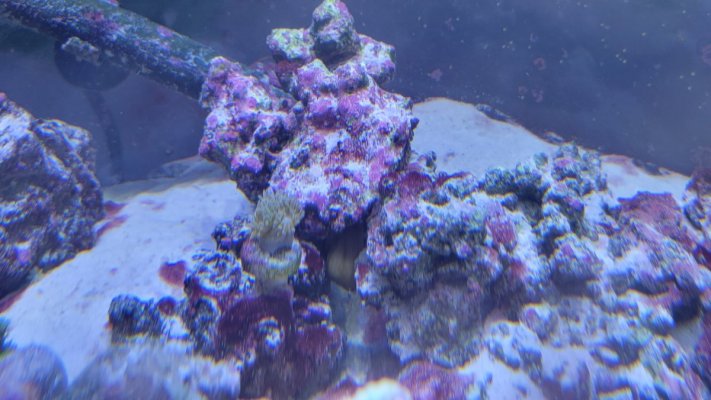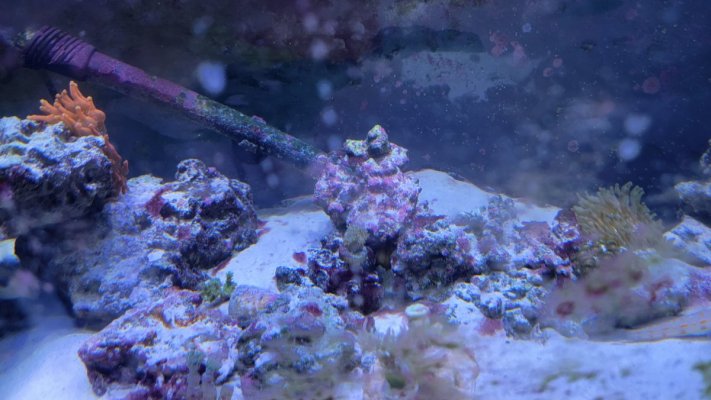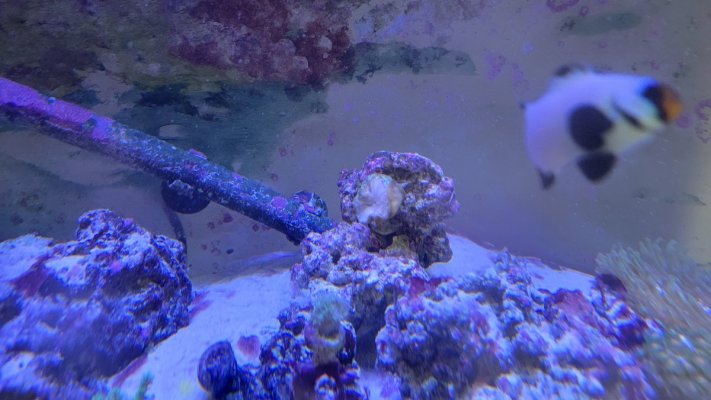Navigation
Install the app
How to install the app on iOS
Follow along with the video below to see how to install our site as a web app on your home screen.
Note: This feature may not be available in some browsers.
More options
You are using an out of date browser. It may not display this or other websites correctly.
You should upgrade or use an alternative browser.
You should upgrade or use an alternative browser.
Closed up green bta
- Thread starter airedwin
- Start date
- Tagged users None
Typically, I would say to give it a bit and see if it moves on its own, but sounds like you’ve already done that? If so, I would remove the top rock of the cave so it can get light and then see how it responds.
Ya, it's been a while since I've seen him open. He's actually hanging from it, maybe I can turn that rock. Thanks I will give it a try.Typically, I would say to give it a bit and see if it moves on its own, but sounds like you’ve already done that? If so, I would remove the top rock of the cave so it can get light and then see how it responds.
I turned the rock over. He looks bad. Still alive I think. Thoughts?Typically, I would say to give it a bit and see if it moves on its own, but sounds like you’ve already done that? If so, I would remove the top rock of the cave so it can get light and then see how it responds.
Attachments
vetteguy53081
Well known Member and monster tank lover
View Badges
Partner Member 2024
Excellence Award
Reef Tank 365
RGB
Article Contributor
Tampa Bay Reef Keepers
West Palm Beach Reefer
Hospitality Award
Ocala Reef Club Member
305 Reef Club
Wisco Reefers
Midwest Reefer
Fish Medic
MAC of SW Florida
Rock Pool Reef Keepers
R2R Secret Santa 2023
My Tank Thread
My Aquarium Showcase
Were these clowns ever in this anemone? They have a habit of Pounding on anemones.
Additionally, anemones are sensitive to changes with water and require pristine conditions to stay in good shape. Failing to meet their needs can result in early death and damage to the tank environment as a whole.
The most important thing you’ll need to take care of before you bring your anemone home is perfecting the tank and water conditions and therefore not a good choice for a newer tank.
Take some time to get parameters just right and let the closed environment cycle for a few months. This ensures that conditions are stable and safe. Anemones prefer warmer temperatures. Water should be on the alkali side as well. Monitor water conditions regularly to avoid any major changes. Ammonia and nitrate levels should be near undetectable at all times using a good quality test kit and Not API either.
Here are some water parameters to follow.
Anemone lighting is a very important part of their care. They need a lot of light to thrive because they’re photosynthetic which means that they absorb light to produce food and growth. The anemone has zooxanthellae in its body, which are symbiotic microorganisms that they feed on. Without proper lighting, the anemone will expel the zooxanthellae and turn white. This process is called bleaching and often leads to death.
A moderate amount of flow is recommended. Many aquarists soon find out that too much flow will cause the anemone to stretch out and look stringy. Keeping things moderate will help avoid this from happening. Avoid directing your flow directly at the anemone. These creatures enjoy subtle movement at all times but too much direct flow hitting the anemone will force it to move.
Additionally, anemones are sensitive to changes with water and require pristine conditions to stay in good shape. Failing to meet their needs can result in early death and damage to the tank environment as a whole.
The most important thing you’ll need to take care of before you bring your anemone home is perfecting the tank and water conditions and therefore not a good choice for a newer tank.
Take some time to get parameters just right and let the closed environment cycle for a few months. This ensures that conditions are stable and safe. Anemones prefer warmer temperatures. Water should be on the alkali side as well. Monitor water conditions regularly to avoid any major changes. Ammonia and nitrate levels should be near undetectable at all times using a good quality test kit and Not API either.
Here are some water parameters to follow.
- Water temperature: Between 77°F and 79°F
- pH level: 8.1 to 8.3
- Alk: 8 to 11 dKH
- Specific gravity: 1.024 to 1.025
- Nitrate < .5
Anemone lighting is a very important part of their care. They need a lot of light to thrive because they’re photosynthetic which means that they absorb light to produce food and growth. The anemone has zooxanthellae in its body, which are symbiotic microorganisms that they feed on. Without proper lighting, the anemone will expel the zooxanthellae and turn white. This process is called bleaching and often leads to death.
A moderate amount of flow is recommended. Many aquarists soon find out that too much flow will cause the anemone to stretch out and look stringy. Keeping things moderate will help avoid this from happening. Avoid directing your flow directly at the anemone. These creatures enjoy subtle movement at all times but too much direct flow hitting the anemone will force it to move.
Thank you. No, these clowns act like they don't know what an anemone is lol. I have two other anemones that are doing well. They are in different areas of the tank though. I will turn down my white and red lights some (I'm doing it anyway cause of the cyano). Do I need to turn down the blue as well? I'm worried about my corals and my other two bta though if I turn them down.Were these clowns ever in this anemone? They have a habit of Pounding on anemones.
Additionally, anemones are sensitive to changes with water and require pristine conditions to stay in good shape. Failing to meet their needs can result in early death and damage to the tank environment as a whole.
The most important thing you’ll need to take care of before you bring your anemone home is perfecting the tank and water conditions and therefore not a good choice for a newer tank.
Take some time to get parameters just right and let the closed environment cycle for a few months. This ensures that conditions are stable and safe. Anemones prefer warmer temperatures. Water should be on the alkali side as well. Monitor water conditions regularly to avoid any major changes. Ammonia and nitrate levels should be near undetectable at all times using a good quality test kit and Not API either.
Here are some water parameters to follow.
When you first introduced the anemone to the tank, ideal would have been toturn down any pumps. The flow should be minimal until the anemone gets settled in. Chances are, your anemone will move around the tank until it finds a suitable spot to call home. If it starts to move towards any coral, simply direct your water jets to the coral. This will discourage the anemone from anchoring near it. It will move to another area to attach.
- Water temperature: Between 77°F and 79°F
- pH level: 8.1 to 8.3
- Alk: 8 to 11 dKH
- Specific gravity: 1.024 to 1.025
- Nitrate < .5
Anemone lighting is a very important part of their care. They need a lot of light to thrive because they’re photosynthetic which means that they absorb light to produce food and growth. The anemone has zooxanthellae in its body, which are symbiotic microorganisms that they feed on. Without proper lighting, the anemone will expel the zooxanthellae and turn white. This process is called bleaching and often leads to death.
A moderate amount of flow is recommended. Many aquarists soon find out that too much flow will cause the anemone to stretch out and look stringy. Keeping things moderate will help avoid this from happening. Avoid directing your flow directly at the anemone. These creatures enjoy subtle movement at all times but too much direct flow hitting the anemone will force it to move.
Are both nems besides this one rainbows?Thank you. No, these clowns act like they don't know what an anemone is lol. I have two other anemones that are doing well. They are in different areas of the tank though. I will turn down my white and red lights some (I'm doing it anyway cause of the cyano). Do I need to turn down the blue as well? I'm worried about my corals and my other two bta though if I turn them down.
if so, it could be chemical warfare.
How many gallons is that tank? Do you run carbon?
Are both nems besides this one rainbows?
if so, it could be chemical warfare.
How many gallons is that tank? Do you run carbon?
Rainbow on left, sick green bta in the middle, green bta on the right.
40G tank
I have carbon, but it could be used up. I didn't bother to replace it because i have a tang and I read they are sensitive to bad carbon.
Tangs are sensitive to the dust if not rinsed well and the carbon is tumbled.
Rainbow on left, sick green bta in the middle, green bta on the right.
40G tank
I have carbon, but it could be used up. I didn't bother to replace it because i have a tang and I read they are sensitive to bad carbon.
but for the nem, this is where it gets tricky. You have a rbta and gbta doing fine. But this one is not. It doesn’t really look bacterial, but could be. It could also be a wild nem and the other are not and vice versa.
If it was me, I would move to a hospital tank with a hob filter, carbon and a clip on light. Would them watch for a few days to see if it perked up. If it did, then I know it is chemical. If not, I would treat with cipro per the cipro sticky in the nem/clownfish section.
even a bucket will work, as long as you can do a hob filter (or other filter) and a heater. Also, do not need a reef light for observation and treatment. Just a 60w equivalent normal light bulb is fine.
Can I move it to a different tank? Params are roughly the same but I can drip acclimate. That tank just has two clowns in it and a regular freshwater light.Tangs are sensitive to the dust if not rinsed well and the carbon is tumbled.
but for the nem, this is where it gets tricky. You have a rbta and gbta doing fine. But this one is not. It doesn’t really look bacterial, but could be. It could also be a wild nem and the other are not and vice versa.
If it was me, I would move to a hospital tank with a hob filter, carbon and a clip on light. Would them watch for a few days to see if it perked up. If it did, then I know it is chemical. If not, I would treat with cipro per the cipro sticky in the nem/clownfish section.
even a bucket will work, as long as you can do a hob filter (or other filter) and a heater. Also, do not need a reef light for observation and treatment. Just a 60w equivalent normal light bulb is fine.
Would an air sponge filter work?
Air sponge would work, but would prefer something with carbon for observation. Treatment would be no carbon.Can I move it to a different tank? Params are roughly the same but I can drip acclimate. That tank just has two clowns in it and a regular freshwater light.
Would an air sponge filter work?
I see, I have an empty 5gal tank I could put it in. I'll use tank water to start. Thanks.Air sponge would work, but would prefer something with carbon for observation. Treatment would be no carbon.
Keep us updated and hoping for the best.I see, I have an empty 5gal tank I could put it in. I'll use tank water to start. Thanks.
Note: be very careful if you are removing the nem from the rock. Take your time and do not tear the foot.
Oh, I'm just going to use same rock to minimize stress and also keep bacteria so I don't have to worry about cycle.Keep us updated and hoping for the best.
Note: be very careful if you are removing the nem from the rock. Take your time and do not tear the foot.
vetteguy53081
Well known Member and monster tank lover
View Badges
Partner Member 2024
Excellence Award
Reef Tank 365
RGB
Article Contributor
Tampa Bay Reef Keepers
West Palm Beach Reefer
Hospitality Award
Ocala Reef Club Member
305 Reef Club
Wisco Reefers
Midwest Reefer
Fish Medic
MAC of SW Florida
Rock Pool Reef Keepers
R2R Secret Santa 2023
My Tank Thread
My Aquarium Showcase
Blue is fineThank you. No, these clowns act like they don't know what an anemone is lol. I have two other anemones that are doing well. They are in different areas of the tank though. I will turn down my white and red lights some (I'm doing it anyway cause of the cyano). Do I need to turn down the blue as well? I'm worried about my corals and my other two bta though if I turn them down.
Ok thanksBlue is fine
Moved him to a hospital tank. Was debating if I should take vetteguy's advice but I figure this gives me both options to reduce chemicals and lower light. But it won't tell me what the problem was.Keep us updated and hoping for the best.
Note: be very careful if you are removing the nem from the rock. Take your time and do not tear the foot.
That pic shows a lot more about the nem. It looks like it may need cipro treatment.Moved him to a hospital tank. Was debating if I should take vetteguy's advice but I figure this gives me both options to reduce chemicals and lower light. But it won't tell me what the problem was.

What is that? Most of his tentacles are retracted and white. There are a few left that are green. His mouth seems ok.That pic shows a lot more about the nem. It looks like it may need cipro treatment.
There is a sticky at the top of the clownfish/anemone section of this forum. It walks you through it.
If mouth is not gaping, it may not need it and just need time to recover from whatever. Does it expand any with no light?
If mouth is not gaping, it may not need it and just need time to recover from whatever. Does it expand any with no light?
Similar threads
- Replies
- 6
- Views
- 206




















